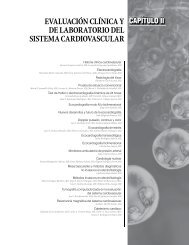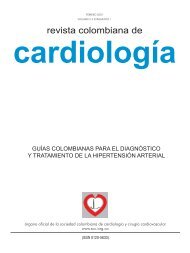Descargar - Scc
Descargar - Scc
Descargar - Scc
You also want an ePaper? Increase the reach of your titles
YUMPU automatically turns print PDFs into web optimized ePapers that Google loves.
- Cuando la historia clínica del paciente demuestra<br />
susceptibilidad al síncope mediado neuralmente.<br />
Clase 2<br />
La mayoría de autores está de acuerdo en su<br />
realización. La prueba de la mesa inclinada estaría<br />
indicada:<br />
- Cuando la respuesta hemodinámica del síncope<br />
inexplicado puede alterar el tratamiento.<br />
- Para diferenciar síncope de cuadros epilépticos.<br />
- Para evaluar pacientes con síncope inexplicado<br />
recurrente.<br />
- Para evaluar presíncope o mareo recurrente.<br />
Clase 3 (prueba de la mesa inclinada<br />
no indicada)<br />
- Evaluación de tratamiento.<br />
- Único episodio sin trauma en un paciente<br />
sin alto riesgo.<br />
- Historia clínica que sugiere síncope vasovagal<br />
si la demostración de susceptibilidad mediada<br />
neuralmente no cambia el tratamiento.<br />
Diagnóstico<br />
La prueba de la mesa inclinada positiva se<br />
considera diagnóstica de síncope mediado neuralmente:<br />
Clase 1<br />
- En pacientes sin enfermedad cardíaca estructural<br />
cuando el síncope espontáneo es reproducido<br />
en la prueba y no requiere otros exámenes.<br />
- En pacientes con enfermedad cardíaca estructural;<br />
las arritmias que inducen síncope u<br />
otras causas cardíacas deben ser excluidas previas<br />
a considerar el resultado de la prueba de la<br />
mesa inclinada positivo como evidencia de síncope<br />
mediado neuralmente.<br />
Clase 2<br />
- La relación entre las características clínicas<br />
y la inducción de síncope no es clara.<br />
Manual de métodos diagnósticos en electrofisiología cardiovascular<br />
NOTA: el síncope de esfuerzo debe alertar al<br />
médico sobre la posibilidad de una cardiopatía<br />
estructural o arrítmica; luego de descartarlas hay<br />
que considerar el síncope vasovagal en el diagnóstico<br />
diferencial.<br />
Bibliografía<br />
1. Kenny RA, Ingram A, Bayliss J, Sutton R. Head-up tilt: a useful test for<br />
investigating unexplained syncope. Lancet 1986; 1: 1352-5.<br />
2. Fitzpatrick AP, Theodorakis G, Vardas P, Sutton R. Methodology<br />
of head-up tilt test in patients with unexplained syncope. J Am<br />
Coll Cardiol 1991; 17: 125-30.<br />
3. Almquist A, Goldenberg IF, Milstein S et al. Provocation of bradycardia<br />
and hypotension by isoproterenol and upright posture in patients whit<br />
unexplained syncope. N Engl J Med 1989; 320: 346-51.<br />
4. Waxman MB, Yao L, Cameron DA, Wald RW, Roseman J.<br />
Isoproterenol induction of vasodepressor-type reaction in<br />
vasodepressor-prone persons. Am J Cardiol 1989; 63: 58-65.<br />
5. Kapoor WN, Brant N. Evaluation of syncope by upright tilt test<br />
with isoproterenol. A nonspecific test. Ann Intern Med 1992;<br />
116: 358-63.<br />
6. Raviele A, Giada F, Brignole M, Menozzi C, et al. Comparison<br />
of diagnostic accuracy of sublingual nitroglycerin test and lowdose<br />
isoproterenol test in patients with unexplained syncope. Am<br />
J Cardiol 2000; 85 (10): 1194-8.<br />
7. Morillo CA, Klein GJ, Zandri S, Yee R. Diagnostic accuracy of a<br />
low-dose isoproterenol head-up tilt protocol. Am Heart J 1995;<br />
129: 901-6.<br />
8. Natale A, Aktar M, Jazayeri M et al. Provocation of hypotension<br />
during head-up tilt in subjects with no history of syncope or<br />
presyncope. Circulation 1995; 92: 54-8.<br />
9. Raviele SA. Value of head-up tilt testing potentiated with<br />
sublingual nitroglycerin to assess the origin of unexplained<br />
syncope. Am J Cardiol 1995; 76: 267-72.<br />
10. Oraii S. Comparing two different protocols for tilt table testing:<br />
sublingual glyceryl trinitrate versus isoprenaline infusions. Heart<br />
1999; 81: 603-5.<br />
11. Raviele A. Diagnostic accuracy of sublingual nitroglycerin test and<br />
low-dose isoproterenol test in patients with unexplained syncope.<br />
A comparative study. Am J Cardiol 2000; 85: 1194-.<br />
12. Bartoletti A. Head-up tilt testing potentiated with oral nitroglycerin.<br />
A randomized trial of the contribution of a drug-free phase and<br />
a nitroglycerin phase in the diagnosis of neurally mediated<br />
syncope. Europace 1999; 1: 183-6.<br />
13. Bartoli P et al. Methodology of head-up tilt testing potentiated<br />
with sublingual nitroglycerin in unexplained syncope. Am J<br />
Cardiol 2000; 85: 1007-11.<br />
14. Briagnole M. Clinical features of adenosine sensitive syncope and<br />
tilt-induced vasovagal syncope. Heart 2000; 83: 24-8.<br />
15. Benditt DG. Tilt table testing for assessing syncope. ACC expert<br />
consensus document. J Am Coll Cardiol 1996; 28: 263-75.<br />
16. Sutton R. Proposed classification for tilt induced vasovagal<br />
syncope. Eur J Cardiac Pacing Electrophysiol 1992; 3:180-18.<br />
17. Brignole M. New classification of haemodynamics of vasovagal<br />
syncope: beyond the VASSIS classification. Analysis of the presyncopal<br />
phase of the tilt test without and with nitroglycerin<br />
challenge. Europace 2000; 2: 66-76.<br />
18. Raviele A, Brignole M. Effect of etilefrine in preventing syncopal<br />
recurrence in patients with vasovagal syncope: a double-blind,<br />
randomized, placebo-controlled trial. The Vasovagal Syncope<br />
International Study. Circulation 1999; 99: 1452-7.<br />
.<br />
147




